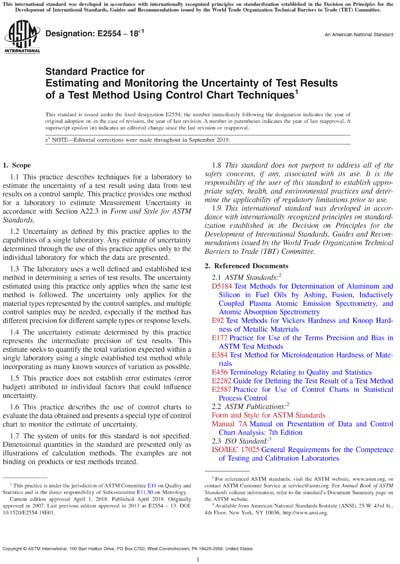Most recent
ASTM E2554-18e1
Standard Practice for Estimating and Monitoring the Uncertainty of Test Results of a Test Method Using Control Chart Techniques
1.1 This practice describes techniques for a laboratory to estimate the uncertainty of a test result using data from test results on a control sample. This practice provides one method for a laboratory to estimate Measurement Uncertainty in accordance with Section A22.3 in Form and Style for ASTM Standards.
1.2 Uncertainty as defined by this practice applies to the capabilities of a single laboratory. Any estimate of uncertainty determined through the use of this practice applies only to the individual laboratory for which the data are presented.
1.3 The laboratory uses a well defined and established test method in determining a series of test results. The uncertainty estimated using this practice only applies when the same test method is followed. The uncertainty only applies for the material types represented by the control samples, and multiple control samples may be needed, especially if the method has different precision for different sample types or response levels.
1.4 The uncertainty estimate determined by this practice represents the intermediate precision of test results. This estimate seeks to quantify the total variation expected within a single laboratory using a single established test method while incorporating as many known sources of variation as possible.
1.5 This practice does not establish error estimates (error budget) attributed to individual factors that could influence uncertainty.
1.6 This practice describes the use of control charts to evaluate the data obtained and presents a special type of control chart to monitor the estimate of uncertainty.
1.7 The system of units for this standard is not specified. Dimensional quantities in the standard are presented only as illustrations of calculation methods. The examples are not binding on products or test methods treated.
1.8 This standard does not purport to address all of the safety concerns, if any, associated with its use. It is the responsibility of the user of this standard to establish appropriate safety, health, and environmental practices and determine the applicability of regulatory limitations prior to use.
1.9 This international standard was developed in accordance with internationally recognized principles on standardization established in the Decision on Principles for the Development of International Standards, Guides and Recommendations issued by the World Trade Organization Technical Barriers to Trade (TBT) Committee.
ASTM International [astm]

